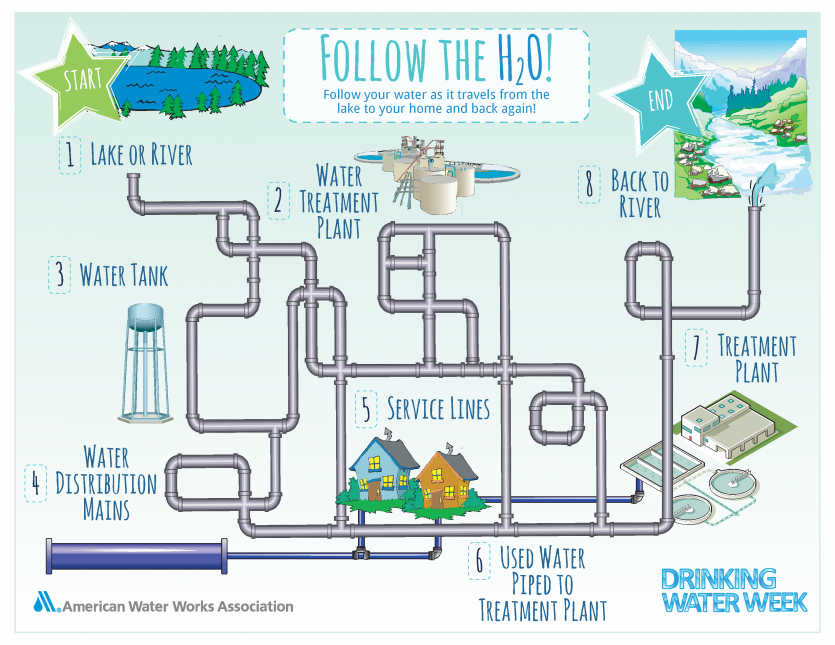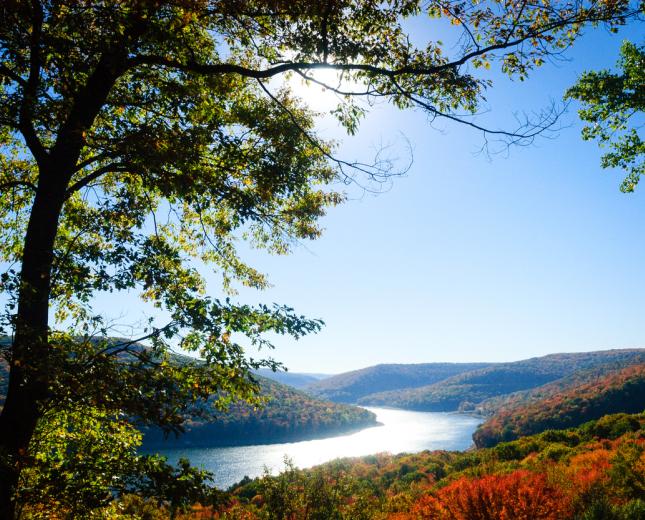
Whether you are an interested community member, student or educator, there's lots to learn! Discover our educational outreach programming, connect with resources and explore your favorite water topics!
Learn with PWSA!
Fill out this form to inquire about PWSA's outreach and extracurricular learning opportunities.
Have you participated in a PWSA Educational Program? Let us know how we did. Your response to our survey is appreciated.

I Want to Learn More About...
Where My Water Comes From
Where My Water Comes From
Your Source Water: The Allegheny River
Our Source Water
The Allegheny River is the source for PWSA's drinking water. The headwaters of the Allegheny is located 352 miles northeast of Pittsburgh.
PWSA's Commitment to Our Source
At PWSA, we are doing our part to conserve and improve the condition of our waterways which means taking steps to manage stormwater and reduce pollution entering our streams and rivers. PWSA’s green infrastructure projects slow the flow of stormwater over land and actions such as separating stormwater flows from pipes which carry sewage significantly improves water quality. We continually monitor the conditions of the Allegheny and collaborate with our community and regulatory partners to protect the integrity of this vital resource.
The History of the Allegheny
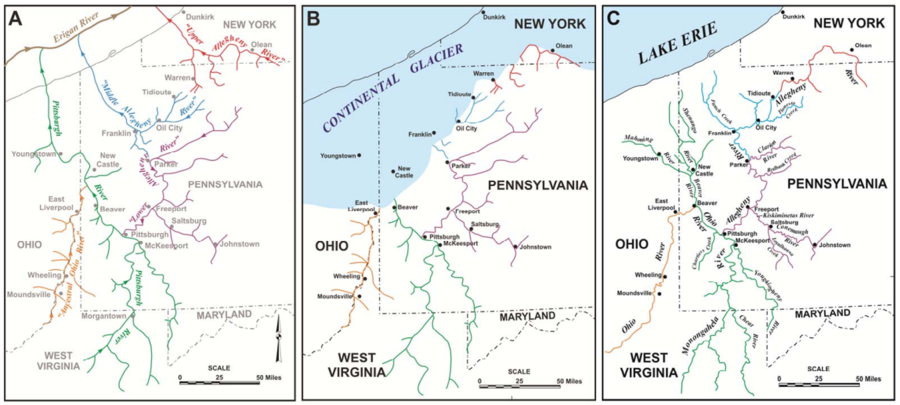
The Allegheny that we know today was largely shaped by the surreal, land-changing forces during the ice ages over 12,000 years ago. Before the most recent ice age, the Allegheny River was comprised of three “little Alleghenies”, all of which used to flow north towards Canada (Picture A). During the ice age, an ice sheet reached as far south as modern day Moraine State Park, south of Erie (Picture B). These little Alleghenies were transformed at the end of the ice age and reshaped into a single river as massive amounts of meltwater from receding glaciers overwhelmed the original waterways. This carved a new path and reversed the flow of the river to a southerly direction (Picture C).
Ecology of the Allegheny
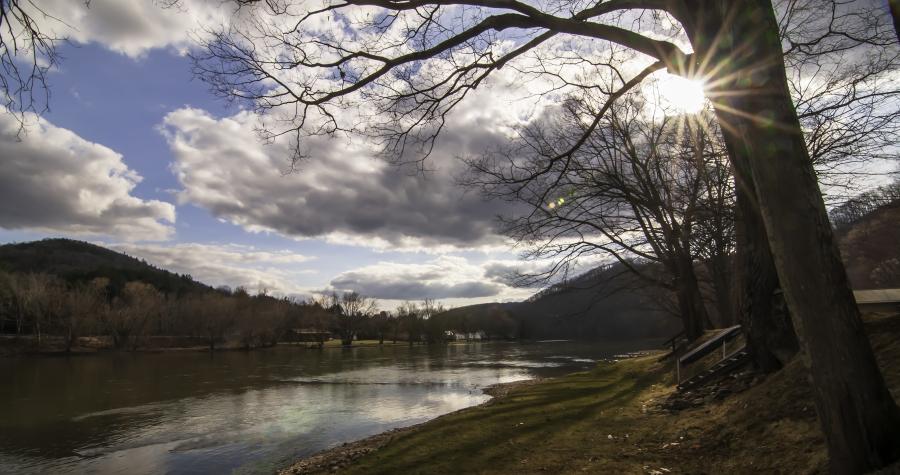
The Allegheny’s riverbed is sandier than the Monongahela and Ohio Rivers which has led many Pittsburghers to recall it as the clearest of our three rivers. This relative clarity hearkens back to its distant ice-age past; the river carries glacial stones and sands southward contributing to the formation of the river’s many islands and supporting the most populous freshwater mussel habitat in the world in its upper stretches.
The Upper Allegheny winds through national forest, pastoral farmland, small towns, and valleys. The scenic nature, remarkable fish and wildlife varieties, and recreational opportunities preserve this upper portion under the 1968 Wild and Scenic Rivers Act. Recognition under this act is a distinction earned by only a tiny percentage of American Rivers. As the Allegheny flows downstream to Pittsburgh, its waters and surrounding environment are protected to benefit current and future generations.
The condition of the upper Allegheny benefits those downstream who receive its waters and is a reminder that clean waterways are the result of collective care and concern. Each individual’s decisions on land affect water and are amplified along the course of the entire river.
Links:
National Wild and Scenic Rivers System
PA Wilds Allegheny River Recreation
National Weather Service Real Time River Monitoring
USGS Water Quality Portal
How My Water Is Treated and Distributed
How My Water Is Treated and Distributed
Where We Provide Service:
To learn where we provide drinking water services, view our Service Area Map.
If your place of residence falls outside of our service area and you are not sure who your provider is, check out the PA DEP's Public Water Systems page. You can type in an address and easily find the water provider for that region.
How Is the Water Treated?
At the Pittsburgh Water and Sewer Authority (PWSA), we take immense pride in delivering clean and safe drinking water to our communities served. We understand the importance of providing transparent information regarding the quality and safety of the water you receive and want to assure you that the water supplied by PWSA meets or surpasses all federal and state regulations for drinking water quality. Our commitment to maintaining the highest standards of water safety is unwavering, and we employ rigorous monitoring and testing procedures to ensure the continued delivery of clean and safe water.
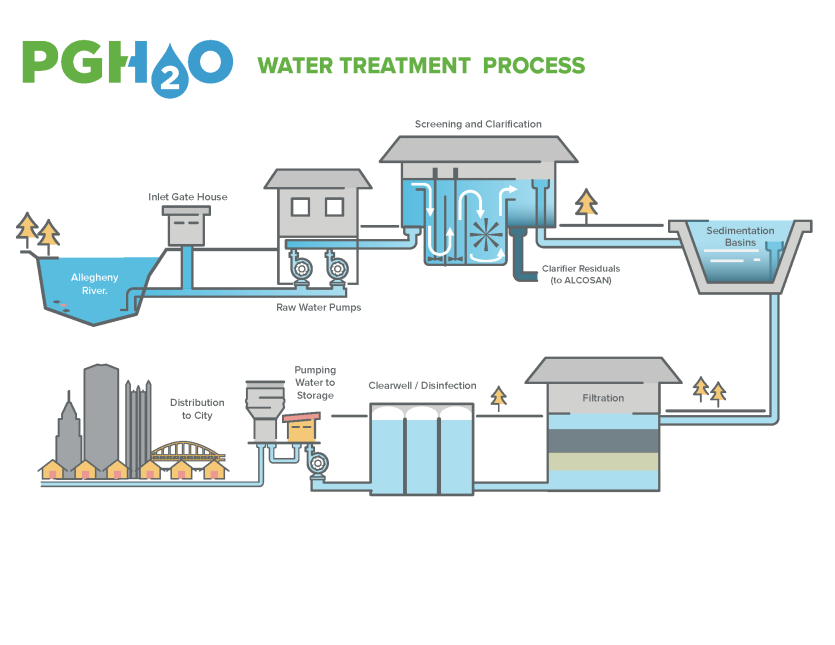
- The Water Treatment Process starts with the Allegheny River. On average, 65–75 million gallons of water from the Allegheny River enter through intake pipes and are lifted to the Screen Room, then moving through a series of screens which filter out leaves and debris.
- Water travels to the Clarifier Building where compounds are added and mixed into the water, causing fine particles like clays and silts to settle out.
- The water is sent to large basins for storage and given additional time to settle. After some time, the water exits and continues to filtration.
- In the Filter Building, water moves through 18 gravity filters filled with carbon and sand to further remove impurities. Chlorine is added to begin disinfection.
- Water enters the 40 million gallon Clearwell to finish disinfection. Additional compounds are added to treat the water and protect pipes from corrosion.
- The water exits the Clearwell and will now enter The Water Distribution System which is comprised of a series of pipes and holding tanks distributing the water to our customers.
The Stormwater System and Managing Runoff
The Stormwater System and Managing Runoff
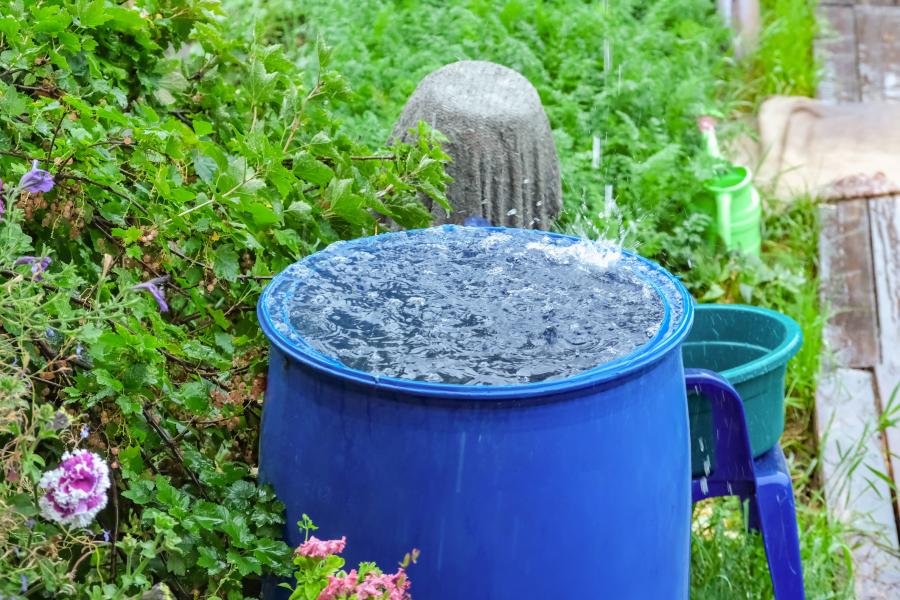
When water flows from your tap or goes down your drain, you don’t necessarily think about it. But there’s a lot of science, engineering, maintenance, and thought to make sure water is managed properly. Explore the links below to learn about the stormwater system, watershed and discover how you can help manage stormwater runoff.
How the Stormwater System Works
Our sewer system includes 1,200 miles of sewer lines and more than 25,000 storm drains. When it rains, stormwater enters inlets along our roadways and other surfaces, and the storm sewer pipes send the stormwater directly to our streams and rivers.
Approximately 75 percent of the sewer system is a Combined System, meaning that stormwater and wastewater (the water you flush down your toilet or water that goes down your drain) flow through the same pipe.
The remaining 25 percent is a Municipal Separate Storm Sewer System (MS4), which means that wastewater flows through one sewer pipe and stormwater flows through another.
We send wastewater to ALCOSAN, the regional wastewater treatment plant along the Ohio River. They treat wastewater for the 83 municipalities in Allegheny County, including the City of Pittsburgh.
Visualize Your Watershed
All precipitation that falls eventually makes its way into a waterway and everything that we do on land eventually affects the water. With this interactive map tool, you can visualize where the many smaller watersheds within Allegheny County. type in your address to discover which waterway receives runoff from your property.
For a more zoomed out look at our watersheds at the state-level, check out PA's Watershed Regions map.
Reducing Pollution: Voluntary Actions and Resources
Reducing Pollution: Voluntary Actions and Resources
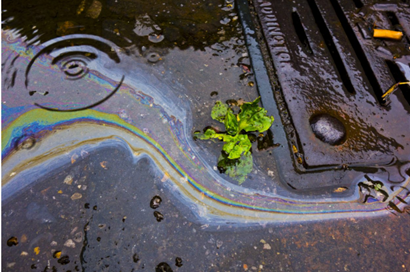
Reducing Pollution To Our Waterways
When it storms, stormwater picks up litter, oil, road salt, and other pollutants on the ground before flowing through storm drains to our streams and rivers. This pollution harms local water quality, fish and wildlife, and recreation.
There is a lot you can do to help reduce pollution from entering our waterways with simple, everyday actions. Visit our Help Manage Stormwater page to discover tips!
Stormwater Resource Links
Southwestern Pennsylvania's Homeowner's Guide to Stormwater: A thorough guide to actions you can take around your home to make a difference in managing stormwater on your property.
Preventing Stormwater Pollution in Our Municipal Operations: A guide for preventing pollution at the municipal level.
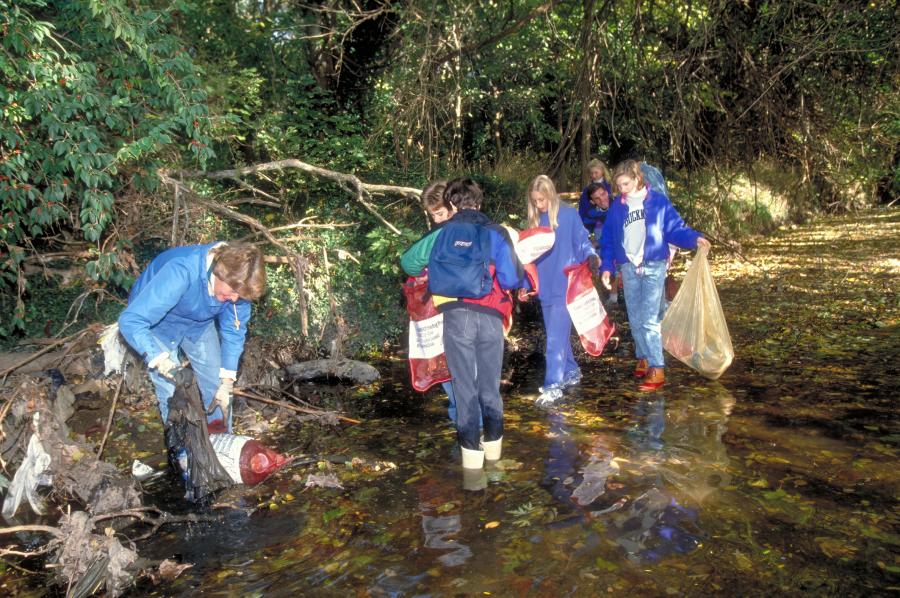
Partners In Cleaner Waterways and Volunteer Opportunities
Allegheny Cleanways: Volunteer opportunities throughout the region including riverfront cleanups and storm grate cleanouts.
Upstream Pittsburgh: Volunteer opportunities including stream sweeps, greenspace workdays and resources for rain barrels.
Penn State Master Watershed Steward Program: Volunteer training on a variety of water resource topics, including groundwater, stream ecology, wetlands, invasive plants, water recreation and stormwater management.
The History of Water Treatment in Pittsburgh
The History of Water Treatment in Pittsburgh
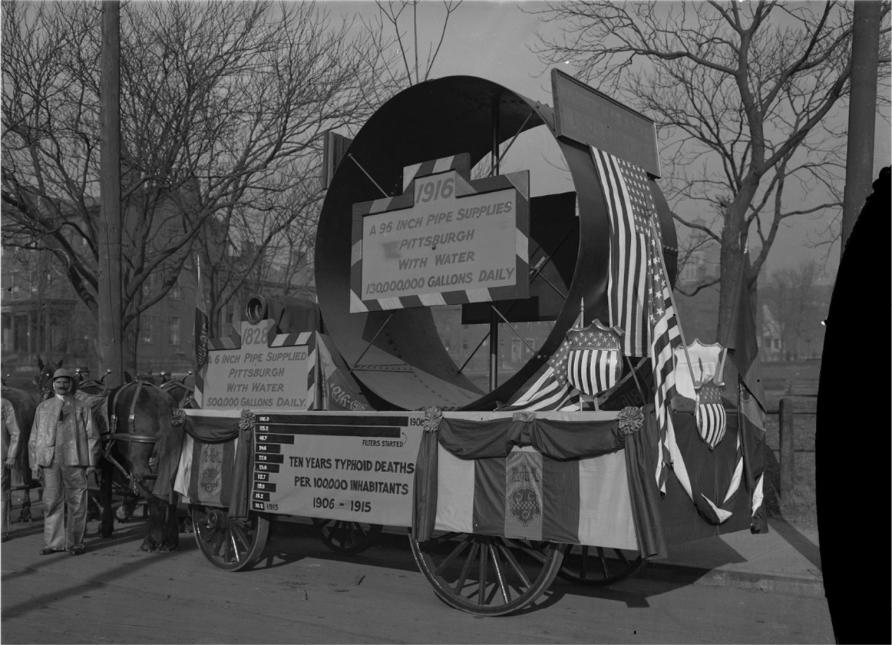 A 1916 Parade celebrates the steep decline in typhoid in Pittsburgh.
A 1916 Parade celebrates the steep decline in typhoid in Pittsburgh.
Before Water Treatment...
Pittsburgh, the city which once produced over half of the nation’s steel, simply would not be if not for the waterways which directly led to the establishment, growth and development of the industries that placed it on the map. For this reason, at the Pittsburgh Water and Sewer Authority (PWSA), our gratitude for our waterways runs deep. As we peer back at the service our rivers have provided to our steel city, we are reminded of their inherent value.
Since the early 1800s, our three rivers have served as an indispensable transport route. With an abundance of coal, iron and timber nearby, Pittsburgh rose to prominence as a steel town with goods coming in by waterways. Water was so important as a transport option that Pittsburghers lobbied in the 1840s to have canals and aqueducts built throughout the city to make the delivery of raw materials by water even easier.
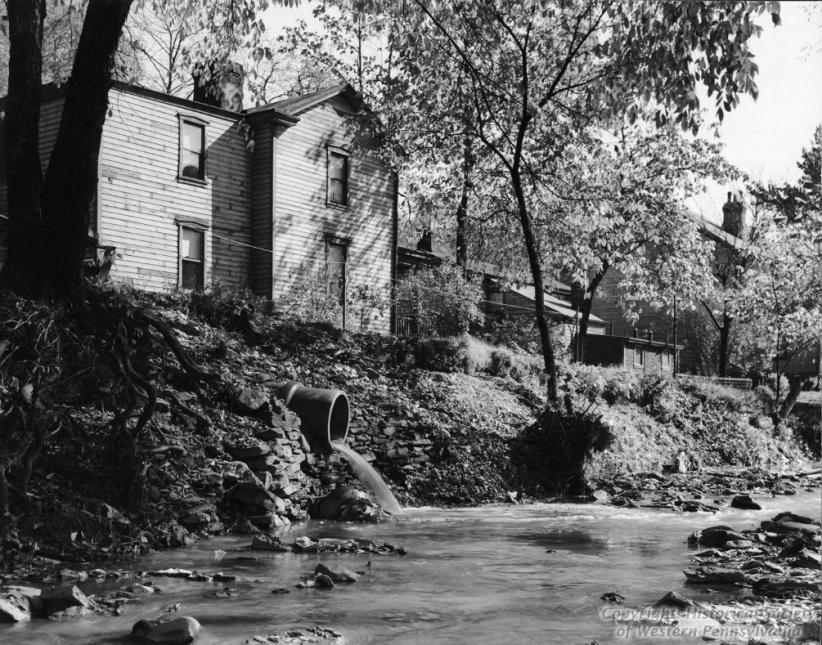 Raw Sewage Flows from a pipe into Saw Mill Run
Raw Sewage Flows from a pipe into Saw Mill Run
The city’s population increased four-fold during the decades of the canal system’s operation, but with a growing population and more industry came less care for our rivers. By the 1880s, hundreds of boats were navigating Pittsburgh’s rivers, waste from factories was being dumped into the water and it was customary for sewage to be sent directly into the river. The terrible result was that Pittsburgh had the highest typhoid fever mortality rate of any city in the nation by the early 1900s. Pittsburgh was highly affected by its poor water conditions, and this is directly linked to lack of water treatment services.
The dismal state of Pittsburgh’s rivers and drinking water would begin to improve as new regulations were set in place and commitments to better public health outcomes became a priority. After seeing the success of filtration plants in other cities, Pittsburgh erected a demonstration filter in 1895 which proved that slow sand filtration was the most economical and effective means at the time to purify the water.
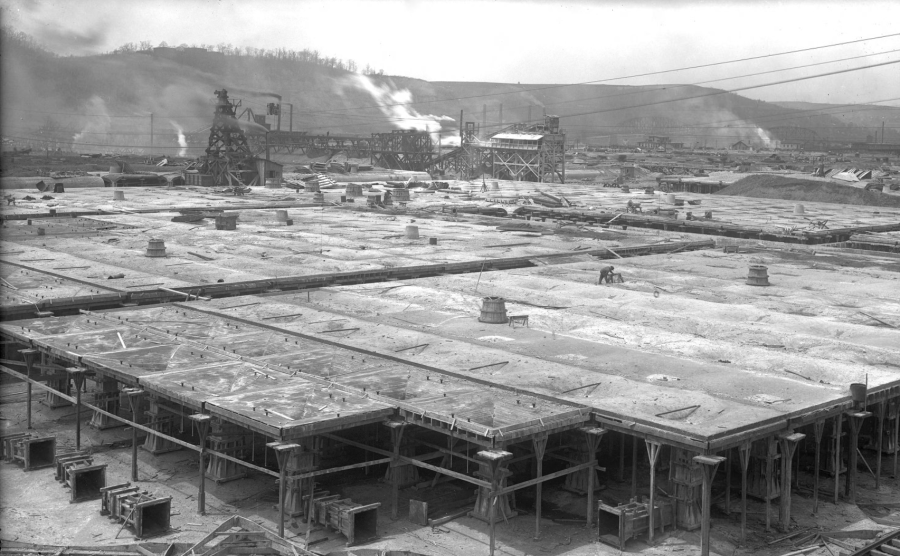 Construction in progress on the slow sand filtration plant, 1907
Construction in progress on the slow sand filtration plant, 1907
Construction of Pittsburgh’s first filtration plant began in 1905 on the northern bank of the Allegheny River on the site of the present-day Waterworks Plaza. The first filtered water was delivered to the city in 1907. All of downtown and the east end was receiving filtered water by the spring of 1908 and South Side by February of 1909. By 1912, rates of Pittsburghers succumbing to typhoid fever would drop by over 900 percent.
Further Reading and links:
The Search for Pure Water in Pittsburgh: The Urban Response to Water Pollution, 1893-1914: Western Pennsylvania History: 1893-1914 | Western Pennsylvania History: 1918 - 2020, journals.psu.edu/wph/article/view/3450/3281.
Blackley, Katie. WESA. Aqueducts, inclines and mules: How the Pennsylvania Canal changed the Commonwealth. Available at: https://www.wesa.fm/development-transportation/2020-04-08/aqueducts-inclines-and-mules-how-the-pennsylvania-canal-changed-the-commonwealth.
The Fate of Sewage and Stormwater from Medieval Times in Europe to Today in Pittsburgh
Student Activities & Games
Elementary School Students
Elementary School Students
DiscoverWater.org
Turn screen time into learning time with free online water games designed for kids ages 7-12! Explore interactive activities and quizzes about different water topics, and build a personalized "Take Action!" poster at DiscoverWater.org.
Test Your WaterSense
Help water-saving hero Flo navigate through a maze of water pipes and answer water-efficiency questions while avoiding Water Waster monsters! Check out the US EPA Test Your WaterSense game and learn more on the US EPA WaterSense for Kids webpage.
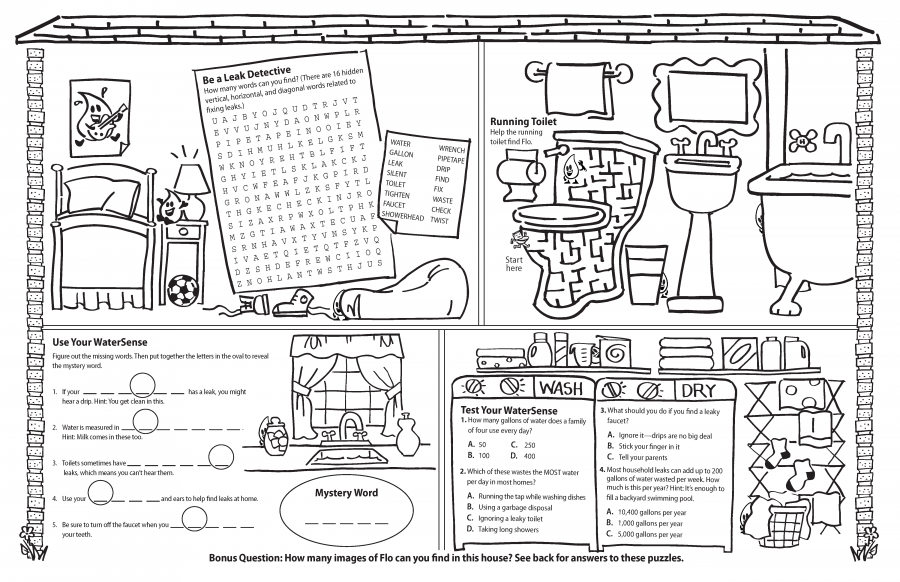
Fix a Leak Puzzle Sheet
Help water-saving hero Flo complete these word puzzles to fix water-wasting leaks around the house! This printable US EPA puzzle sheet is available in English or Español. Learn more on the US EPA WaterSense for Kids webpage.
The Basics of Freshwater: Crash Course Kids 14.1
We have a lot of water on Earth, but we can't actually drink most of it. This YouTube episode of Crash Course Kids based on 5th-grade science explains the difference between freshwater and saltwater and why freshwater is so important.
Freddy the Fish Teaches About Stormwater
In this YouTube video created by the North Central Texas Council of Governments, Freddy the Fish explains what happens to rain after it hits the ground, where storm drains lead to, and what we can do to help prevent water pollution.
Pittsburgh Watershed Bingo
Play a game of watershed bingo with this bingo card created by the Pittsburgh Parks Conservancy! Go on a walk with the card and mark off the living and non-living things related to water that you see.
Pittsburgh One Water Exploration Worksheet
Explore local watersheds using the fun activities in this worksheet created by the Pittsburgh Parks Conservancy for all ages! You'll learn about our local rivers, streams, rainwater, and drinking water.
Water Word Scramble
Flex your brain by unscrambling words and learning water facts! Put the scrambled letters in the correct order to complete the sentences in this US EPA word scramble designed for grades 4-8.
Aquatic Crusader Experiments
Join Darby Duck, the Aquatic Crusader in the fight against water pollution! Try out the seven experiments on the US EPA website to learn about the characteristics of water and how it interacts with other elements in the environment, some of which pollute it.
Stormwater Walk
Be a stormwater sleuth! Take a walk around your home or school and tally things that affect stormwater, such as trees, downspouts, and storm drains. Use this activity designed by the University of Nebraska - Lincoln for grades 4-6 to calculate a stormwater score for your home or school.
Crumpled Watershed Model
Make your own watershed model with just a few sheets of paper! Follow this activity designed by the University of Nebraska - Lincoln for grades 4-6 to make it "rain" over your watershed model and learn how watersheds work.
Green Your Home: Improving Water Conservation
It’s easy to waste water and even easier to take clean water for granted. This activity from Project Learning Tree has questions and tips to help you identify places where you can make changes to save water. Printable versions are available in English and Español.
Green Your Home: Improving Outdoor Spaces
There are many simple things you can do to make your yard, patio, or windows better for your family, wildlife, and the environment. Use the questions in this activity from Project Learning Tree to identify positive changes you can make. Printable versions are available in English and Español.
What's the Value of That Tree?
Trees do more than provide products such as fruits and wood. They also improve air quality by absorbing carbon dioxide and pollution, reduce flood risks due to rainfall, and provide energy savings by reducing the need for heating and cooling. This activity from Project Learning Tree will help you calculate the value of a tree. A printable version is available in English.
Coloring Pages
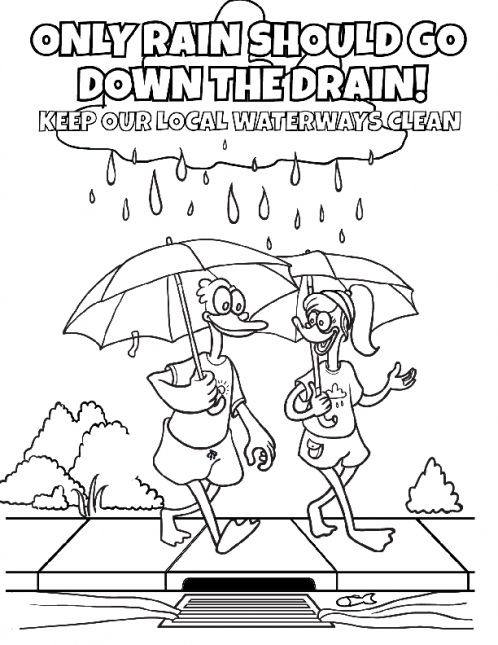
Learn about the water cycle and good water habits while making art
Middle School Students
Middle School Students
DiscoverWater.org
Turn screen time into learning time with free online water games designed for kids ages 7-12! Explore interactive activities and quizzes about different water topics, and build a personalized "Take Action!" poster at DiscoverWater.org.
Test Your WaterSense
Help water-saving hero Flo navigate through a maze of water pipes and answer water-efficiency questions while avoiding Water Waster monsters! Check out the US EPA Test Your WaterSense game and learn more on the US EPA WaterSense for Kids webpage.
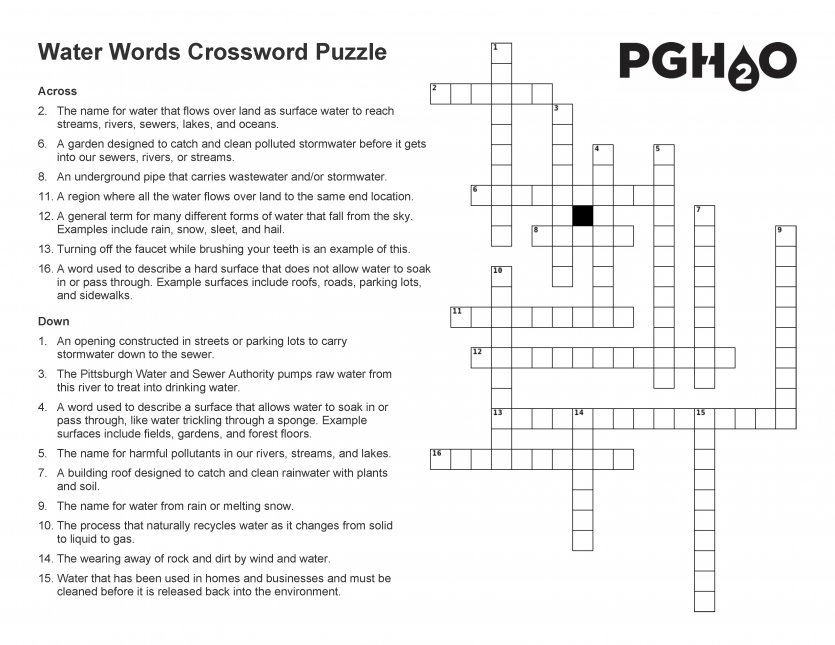
Pittsburgh Water Words Crossword Puzzle
Quiz yourself on water words relevant to Pittsburgh! Fill out this crossword puzzle on the Crossword Labs website or download a printable version. Check your answers using the key.
Take the Stormwater Runoff Challenge
Test your understanding of water facts and pollution with this fun crossword puzzle from the US EPA. The printable crossword puzzle can also be used as a placemat.
Runoff Simulation
Use this animated model created by Stroud Water Research Center to learn how land use and soil together determine whether rainfall infiltrates into the soil, runs off into streams, or is evaporated and transpired by plants.
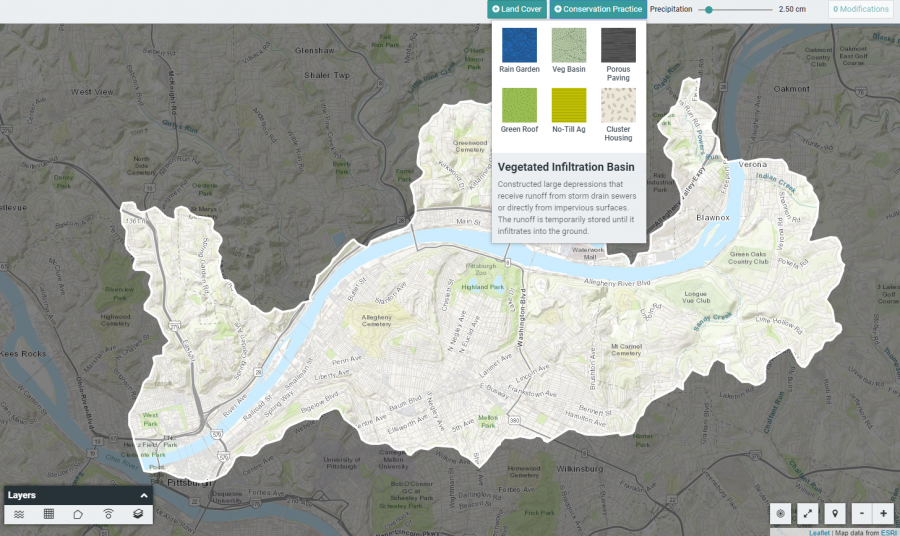
Model My Watershed
Use this web app created by Stroud Water Research Center to analyze real land use and soil data in your neighborhood or watershed, model stormwater runoff and water-quality impacts, and compare different conservation or development scenarios.
How's My Waterway
Research the condition of your local, state, and national waters using this web app created by the US EPA. Learn about water quality impacts and how you can help protect your local waterways.
Pollution Awareness: What's Wrong with This Picture?
Scout out the scene and look for places where someone's actions might be harming the environment! Check out this detective game on the US EPA website.
Pollution Awareness Word Search Puzzle
Learn more about stormwater pollution and how to prevent it while completing a word search puzzle designed for grades 6-9! Check out the puzzle on the US EPA website or download a printable version.
Pittsburgh One Water Exploration Worksheet
Explore local watersheds using the fun activities in this worksheet created by the Pittsburgh Parks Conservancy for all ages! You'll learn about our local rivers, streams, rainwater, and drinking water.
Water Word Scramble
Flex your brain by unscrambling words and learning water facts! Put the scrambled letters in the correct order to complete the sentences in this US EPA word scramble designed for grades 4-8.
Aquatic Crusader Experiments
Join Darby Duck, the Aquatic Crusader in the fight against water pollution! Try out the seven experiments on the US EPA website to learn about the characteristics of water and how it interacts with other elements in the environment, some of which pollute it.
Stormwater Walk
Be a stormwater sleuth! Take a walk around your home or school and tally things that affect stormwater, such as trees, downspouts, and storm drains. Use this activity designed by the University of Nebraska - Lincoln for grades 4-6 to calculate a stormwater score for your home or school.
Crumpled Watershed Model
Make your own watershed model with just a few sheets of paper! Follow this activity designed by the University of Nebraska - Lincoln for grades 4-6 to make it "rain" over your watershed model and learn how watersheds work.
Green Your Home: Improving Water Conservation
It’s easy to waste water and even easier to take clean water for granted. This activity from Project Learning Tree has questions and tips to help you identify places where you can make changes to save water. Printable versions are available in English and Español.
Green Your Home: Improving Outdoor Spaces
There are many simple things you can do to make your yard, patio, or windows better for your family, wildlife, and the environment. Use the questions in this activity from Project Learning Tree to identify positive changes you can make. Printable versions are available in English and Español.
What's the Value of That Tree?
Trees do more than provide products such as fruits and wood. They also improve air quality by absorbing carbon dioxide and pollution, reduce flood risks due to rainfall, and provide energy savings by reducing the need for heating and cooling. This activity from Project Learning Tree will help you calculate the value of a tree. A printable version is available in English.
High School Students
High School Students

Pittsburgh Water Words Crossword Puzzle
Quiz yourself on water words relevant to Pittsburgh! Fill out this crossword puzzle on the Crossword Labs website or download a printable version. Check your answers using the key.
Take the Stormwater Runoff Challenge
Test your understanding of water facts and pollution with this fun crossword puzzle from the US EPA. The printable crossword puzzle can also be used as a placemat.
Runoff Simulation
Use this animated model created by Stroud Water Research Center to learn how land use and soil together determine whether rainfall infiltrates into the soil, runs off into streams, or is evaporated and transpired by plants.

Model My Watershed
Use this web app created by Stroud Water Research Center to analyze real land use and soil data in your neighborhood or watershed, model stormwater runoff and water-quality impacts, and compare different conservation or development scenarios.
How's My Waterway
Research the condition of your local, state, and national waters using this web app created by the US EPA. Learn about water quality impacts and how you can help protect your local waterways.
Pollution Awareness: What's Wrong with This Picture?
Scout out the scene and look for places where someone's actions might be harming the environment! Check out this detective game on the US EPA website.
Pollution Awareness Word Search Puzzle
Learn more about stormwater pollution and how to prevent it while completing a word search puzzle designed for grades 6-9! Check out the puzzle on the US EPA website or download a printable version.
Pittsburgh One Water Exploration Worksheet
Explore local watersheds using the fun activities in this worksheet created by the Pittsburgh Parks Conservancy for all ages! You'll learn about our local rivers, streams, rainwater, and drinking water.
Aquatic Crusader Experiments
Join Darby Duck, the Aquatic Crusader in the fight against water pollution! Try out the seven experiments on the US EPA website to learn about the characteristics of water and how it interacts with other elements in the environment, some of which pollute it.
Green Your Home: Improving Water Conservation
It’s easy to waste water and even easier to take clean water for granted. This activity from Project Learning Tree has questions and tips to help you identify places where you can make changes to save water. Printable versions are available in English and Español.
Green Your Home: Improving Outdoor Spaces
There are many simple things you can do to make your yard, patio, or windows better for your family, wildlife, and the environment. Use the questions in this activity from Project Learning Tree to identify positive changes you can make. Printable versions are available in English and Español.
Youth Video Lessons
Youth Video Lessons
Did you know that you live within a watershed? Everyone does! Learn more about how watersheds work by creating your own watershed model at home using just paper, markers, water, and towels.
Hand washing. How do soap and water clean your hands?
You probably already know that it is important to wash your hands often to stay healthy and prevent the spread of harmful germs. But do you know how the combined power of soap and water gets your hands clean? This demonstration shows a quick hand washing experiment that you can do at home with just cooking oil, soap, and tap water!
Stormwater. How does it impact our rivers and streams?
When it rains, all that water picks up dirt, debris, and pollution left on city streets. It enters our sewer system and can overflow into our rivers and streams. What impact does this have on local waterways? Would you want to go swimming or boating in a river polluted with sewage? Do you think that is good for fish? This demonstration shows the challenges caused by too much rain. Watch and try it at home using this activity guide with materials and instructions!
More Videos
Check out our YouTube Channel to see what we are doing in the community. We are developing more video content to help highlight many of our projects and programs. Click subscribe to see what's coming next!
Watersheds. Why do they matter?


